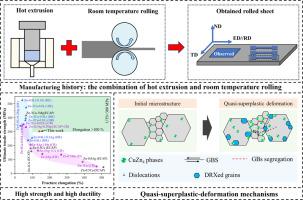Achieving ambient temperature quasi-superplasticity in a high strength Zn-2Cu-0.15Mg alloy with ultrafine/fine grained structure
IF 14.3
1区 材料科学
Q1 MATERIALS SCIENCE, MULTIDISCIPLINARY
引用次数: 0
Abstract
Zinc (Zn) alloys are regarded as one of the most promising candidates to replace traditional implant metals due to their moderate degradation rate and good biocompatibility. Superplastic Zn alloys are favorable for the forming of complex medical devices, however, superplastic alloys usually exhibit relatively low strength. In this work, the alloy design concept for biodegradable Zn is employed to break the trade-off between strength and ductility. Quasi-superplasticity was achieved in a high-strength Zn-2Cu-0.15Mg alloy with a bimodal grain structure (ultrafine and fine grains) through a combined process of hot extrusion and room-temperature (RT) rolling. RT tensile tests were subsequently conducted under various strain rates. Notably, the processed alloys demonstrated an outstanding combination of properties: a quasi-superplastic strain of approximately 138.2%, a yield strength (YS) of ∼219.5 MPa, and ultimate tensile strength (UTS) of ∼301.5 MPa at a strain rate of 1 × 10⁻⁴ s⁻¹. Using quasi-in-situ electron backscatter diffraction (EBSD) analyses, we systematically investigated the microstructure and texture evolution of the rolled alloy during quasi-superplastic deformation at different strains. The findings indicated that the ultrafine grains experienced grain rotation and grain boundary sliding (GBS), whereas dislocation creep was predominant in fine grains. Dynamic recrystallization (DRX) and GBS significantly contributed to the quasi-superplastic strain during tensile deformation. Additionally, numerous spherical submicron-sized CuZn₄ phases created abundant phase interfaces, which facilitate quasi-superplastic deformation through phase boundary sliding (PBS).

一种具有超细/细晶组织的高强度Zn-2Cu-0.15Mg合金实现了室温准超塑性
锌合金因其良好的生物相容性和较好的降解率而被认为是替代传统金属种植体的理想材料之一。超塑性锌合金有利于形成复杂的医疗器械,然而,超塑性合金通常表现出相对较低的强度。在这项工作中,采用可生物降解锌合金的设计理念来打破强度和延展性之间的权衡。采用热挤压和室温轧制相结合的方法,获得了一种具有双峰晶型(超细晶和细晶)的高强度Zn-2Cu-0.15Mg合金的准超塑性。随后在不同应变速率下进行RT拉伸试验。值得注意的是,加工后的合金表现出突出的性能组合:准超塑性应变约为138.2%,屈服强度(YS)为~ 219.5 MPa,在应变率为1 × 10⁻⁴毒副¹时的极限抗拉强度(UTS)为~ 301.5 MPa。采用准原位电子背散射衍射(EBSD)分析方法,系统研究了轧制合金在不同应变下的准超塑性变形过程中的组织和织构演变。结果表明:超细晶粒发生了晶粒旋转和晶界滑动(GBS),而细晶粒以位错蠕变为主;动态再结晶(DRX)和GBS对拉伸变形过程中的准超塑性应变有显著影响。此外,大量的球形亚微米级硫酸铜相形成了丰富的相界面,有利于通过相边界滑动(PBS)进行准超塑性变形。
本文章由计算机程序翻译,如有差异,请以英文原文为准。
求助全文
约1分钟内获得全文
求助全文
来源期刊

Journal of Materials Science & Technology
工程技术-材料科学:综合
CiteScore
20.00
自引率
11.00%
发文量
995
审稿时长
13 days
期刊介绍:
Journal of Materials Science & Technology strives to promote global collaboration in the field of materials science and technology. It primarily publishes original research papers, invited review articles, letters, research notes, and summaries of scientific achievements. The journal covers a wide range of materials science and technology topics, including metallic materials, inorganic nonmetallic materials, and composite materials.
 求助内容:
求助内容: 应助结果提醒方式:
应助结果提醒方式:


